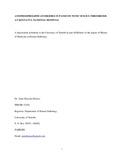| dc.description.abstract | Background: Antiphospholipid antibodies are autoimmune immunoglobulins directed against protein phospholipid complexes. They have been associated with, among other manifestations, an increased risk of thrombosis. The identification of patients with antiphospholipid antibody-associated thrombosis has an important implication on patient management, as these are patients who should benefit from prolonged anticoagulant therapy, to prevent recurrent thrombosis. Objective: To determine the presence of antiphospholipid antibodies and to identify their clinical and laboratory associations in patients with venous thrombosis at Kenyatta National Hospital Study design: A cross-sectional descriptive study Setting: This study was conducted at Kenyatta National Hospital (KNH), a major referral and teaching hospital in Nairobi, Kenya, between January and November 2011. The study areas included the Accident and Emergency department, medical wards and outpatient clinics, Obstetrics and Gynaecology wards and outpatient clinics, and Biochemistry, Haematology and Immunology laboratories. Participants: Male and female adult patients diagnosed with venous thrombosis confirmed by Doppler ultrasound or MRI. Main outcome measures: Age, gender, clinical data (pain, pallor, jaundice, skin manifestations, site of thrombosis), associations (cigarette smoking, hypertension, previous thrombosis, recent surgery, pregnancy, puerperium, oral hormone contraceptive use), and laboratory results (presence or absence of lupus anticoagulant, titres of anticardiolipin (ACL)and anti-β2-GP1 antibodies (anti-β2GP1), TBC, ESR, PBF, reticulocyte count, coagulation tests, serum creatinine and ALT,VDRL and TPHA). Material and Methods: Demographic and clinical information was collected by direct interview of patients. Every patient was examined for clinical manifestations of APA and blood drawn for laboratory tests. A proforma questionnaire was used to collect all the information. The data collected was pooled, screened and entered into SPSS v.19 software for analysis.
Results: A total of 60 patients were studied. Majority of the patients, 52 (86.7%), were females, while males were 8 (13.3%). The mean age was 38.3 years (± 13.7), with a median (IQR) of
52years (38.8, 58) for males vs. 32.5 years (24.8, 43.5) for females, p value <0.05). Fifty-five patients (91.7%) presented with pain and swelling of the lower limb. Twelve patients (20%) had previous history of DVT and 9 (15%) were hypertensive. Of all the patients, 55(91.7%) were non-smokers.43 (82.7%) of the female patients were not pregnant at presentation. Two patients (3.8%) were in puerperium. Fifteen patients (28.9%) were using oral hormonal contraceptives at the time of thrombosis. Thirteen patients (21.7%) had pallor, and 3 (5%) presented with jaundice. All 59patients (98.3%) had no skin manifestations, except for a single case of a malar rash. Fifty-seven patients (95%) had lower limb thrombosis. The mean red cell count was 4.1(SD ± 0.8), haemoglobin level 11.4 g/dL (SD ± 2), platelet count 275 x 109/L (SD ± 145.6), and absolute reticulocyte count 54.2 x 109/L (SD ± 29.8). The mean APTT value was 38.4 seconds (± 15.1) with20 patients (33.3%) having prolonged values. Two patients (10%) had a prolonged KCT (RI >0.16; positive for LA), and all 20 (100%) who had a prolonged APTT had a negative DRVVT (NR <1.30; negative for LA). Fifty-five patients (91.7%) tested negative for VDRL. Of the 5 patients who tested positive for VDRL, 4 (80%) were also positive for TPHA. The mean anticardiolipin IgG titre was 107.4 U/mL (SD ± 62.4); 55 patients (91.7%) had a positive ACL result. The media anti-beta-2-glycoprotein IgG titre was 5 G units (IQR= 4.5, 6.5); 55 patients (91.7%) had a negative result. The mean serum creatinine and ALT concentrations were 98.2 μmol/L (SD ± 57.7) and16.4 IU/L (SD ± 19.5) respectively. A significant positive correlation existed between APTT and ACL (r=0.39) and between ACL and β2GP1 (r=0.30), and a significant negative correlation (r= -0.29) between platelet count and haemoglobin levels. Conclusions: Antiphospholipid antibodies (LA and anti-β2GP1 IgG antibodies) are present in a very small proportion of patients seen at KNH with venous thrombosis. ACL IgG antibodies may be induced by numerous factors and may not be related to thrombosis. DVT in our setting is more common in females of reproductive age, while affected males tend to be older. The lower limb is the most common site of DVT. Pathological antiphospholipid antibodies and their associated clinical and laboratory manifestations are uncommon in patients seen at KNH with VTE.
Recommendations: Screening for antiphospholipid antibodies in patients with venous thrombosis at KNH should be limited to those of a relatively young age, with unprovoked thrombosis or recurrent thrombosis. An LA assay in combination with a β2GP1 antibody assay would be more useful than ACL testing, unless local reference ranges are established. | en_US |

